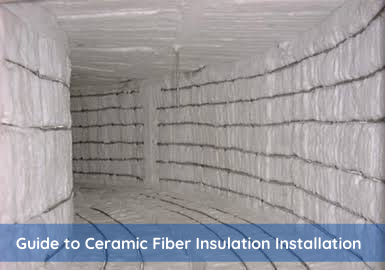
A ceramic fiber insulation system is used as a replacement for the refractory firebricks. Ceramic fiber insulation can be found in bulk, board, blocks, and blankets of all thicknesses and densities.
The historical insulation solution for 1300°C heat treatment furnaces has been to use hard refractory firebricks and lightweight insulating firebricks with high heat storage, high wall heat losses and long heating time to stability. In modern heat-treatment furnaces, these three problems are reduced with ceramic fiber modules lining the walls, roof, doors, flues and stack, using less thickness than insulating firebricks.
Due to the high density of refractory and insulating materials, heat storage, wall heat losses and time required to reach equilibrium are fuel-consumption elements. Also, due to the material weight and thickness of this type of insulation, a heavy furnace structure is required.
With the use of ceramic fiber due to the lower density, heat storage is reduced, less time to equilibrium is required and wall losses can be reduced. Depending on the wall, door and roof thickness, thermal insulation with high-temperature ceramic fiber insulation enables a more lightweight furnace construction, resulting in many economic and ecological benefits. Another excellent advantage is faster operating-temperature recovery time after loading and closing the furnace door.
Although we might think that the installation of insulation in an industrial furnace is a simple matter, the reality is that when it is carried out without the appropriate engineering studies, it is most likely that we will later encounter some common problems, such as:
Heat leaks that are generated by not having the necessary precautions to protect the areas where the material shrinks.
Degradation due to the poor quality or poor choice of fiber.
Furnace roofs that partially detach or falls, resulting in heat leakage.
ADVANTAGES OF CERAMIC FIBER OVER REFRACTORY BRICK
1. AVOIDING THERMAL SHOCK
When working with high temperatures of 1100°C and opening the furnace in operation, the thermal shock from cooling can cause refractory material to break or for fractures to appear so it will affect its operation and life.
2. OPTIMIZED ENERGY CONSUMPTION
To heat refractory brick until the desired furnace temperature is achieved, a large amount of energy is required due to its higher density. In ceramic fibre in order to achieved the required temperature large amount of energy not required.
3. FASTER INSTALLATION ON WIDE PROOFS
The installation of refractory bricks in furnace roofs needs a considerable reinforcement in the structure to support the brick arch. This installation is faster with ceramic fibre due to its lightness and versatility.
4. MAINTENANCE FREE
Our ceramic insulation material is extremely resistant so damage to the fibre won’t affect production much moiré like refractory bricks.
While our product lines are world-class quality and competitively priced, JRFURNACE’s strength is our ability to understand customer’s applications.
Our Applications Engineers are more than happy to speak with you regarding your process heating needs and for any issues! Please give us a call at +91-7604915438/7867018921, or send us an email at [email protected].
